3-D/3-D Z-Scheme Heterojunction Composite Formed by Marimo-like Bi2WO6 and Mammillaria-like ZnO for Expeditious Sunlight Photodegradation of Dimethyl Phthalate
Abstract
1. Introduction
2. Results and Discussion
2.1. Characterization of Prepared Photocatalysts
2.2. Photocatalytic Performance
2.3. Catalyst Recycle and Phytotoxicity Assessment
2.4. Photocatalytic Mechanism
2.4.1. Optical Absorption and Energy Band Structure Analyses
2.4.2. Charge Carrier Dynamics
2.4.3. Identification of Predominant Active Species
2.4.4. Mechanism for Improved Photoactivity of BWZ Composite
3. Materials and Methods
3.1. Chemicals and Materials
3.2. Photocatalyst Preparation
3.3. Characterization
3.4. Photoactivity Test
3.5. Photoelectrochemical Study
3.6. Detection of Active Species
4. Conclusions
Author Contributions
Funding
Data Availability Statement
Conflicts of Interest
References
- Xu, L.J.; Chu, W.; Graham, N. A systematic study of the degradation of dimethyl phthalate using a high-frequency ultrasonic process. Ultrason. Sonochem. 2013, 20, 892–899. [Google Scholar] [CrossRef]
- Zhu, X.; Liu, H.; Wang, Z.; Tian, R.; Li, S. Dimethyl phthalate damages Staphylococcus aureus by changing the cell structure, inducing oxidative stress and inhibiting energy metabolism. J. Environ. Sci. 2021, 107, 171–183. [Google Scholar] [CrossRef] [PubMed]
- Xue, J.; Zhu, Z.; Zong, Y.; Huang, C.; Wang, M. Oxidative degradation of Dimethyl Phthalate (DMP) by the Fe(VI)/H2O2 process. ACS Omega 2019, 4, 9467–9472. [Google Scholar] [CrossRef] [PubMed]
- Panagiotou, E.M.; Ojasalo, V.; Damdimopoulou, P. Phthalates, ovarian function and fertility in adulthood. Best Pract. Res. Clin. Endocrinol. Metab. 2021, 35, 101552. [Google Scholar] [CrossRef]
- Lam, S.M.; Sin, J.C.; Abdullah, A.Z.; Mohamed, A.R. Photocatalytic degradation of resorcinol, an endocrine disrupter, by TiO2 and ZnO suspensions. Environ. Technol. 2013, 34, 1097–1106. [Google Scholar] [CrossRef] [PubMed]
- Vahid, J.; Marzieh, M. Photo-assisted advanced oxidation processes for efficient removal of anionic and cationic dyes using Bentonite/TiO2 nano-photocatalyst immobilized with silver nanoparticles. J. Mol. Struc. 2021, 1239, 130496. [Google Scholar]
- Ahmed, F.A.; Sabah, M.A.; Samir, M.H.; Munirah, A.A.; Naser, M.A.; Sajadi, S.M. Effect of different pH values on growth solutions for the ZnO nanostructures. Chin. J. Phys. 2021, 71, 175–189. [Google Scholar]
- Lam, S.M.; Sin, J.C.; Mohamed, A.R. Fabrication of ZnO nanorods via a green hydrothermal method and their light driven catalytic activity towards the erasure of phenol compounds. Mater. Lett. 2016, 167, 141–144. [Google Scholar] [CrossRef]
- Sin, J.C.; Lim, C.A.; Lam, S.M.; Mohamed, A.R.; Zeng, H.H. Facile synthesis of novel ZnO/Nd-doped BiOBr composites with boosted visible light photocatalytic degradation of phenol. Mater. Lett. 2019, 248, 20–23. [Google Scholar] [CrossRef]
- Wang, J.; Wang, G.; Wei, X.; Liu, G.; Li, J. ZnO nanoparticles implanted in TiO2 macrochannels as an effective direct Z-scheme heterojunction photocatalyst for degradation of RhB. Appl. Surf. Sci. 2018, 456, 666–675. [Google Scholar] [CrossRef]
- Wang, H.; Yu, J.; Zhan, X.; Chen, L.; Sun, Y.; Shi, H. Direct 2D/2D Z-scheme SnNb2O6/ZnO hybrid photocatalyst with enhanced interfacial charge separation and high efficiency for pollutants degradation. Appl. Surf. Sci. 2020, 528, 146938. [Google Scholar] [CrossRef]
- Ni, Z.; Shen, Y.; Xu, L.; Xiang, G.; Chen, M.; Shen, N.; Li, K.; Ni, K. Facile construction of 3D hierarchical flower-like Ag2WO4/Bi2WO6 Z-scheme heterojunction photocatalyst with enhanced visible light photocatalytic activity. Appl. Surf. Sci. 2022, 576, 151868. [Google Scholar] [CrossRef]
- Belousov, A.S.; Fukina, D.G.; Koryagin, A.V. Metal–organic framework-based heterojunction photocatalysts for organic pollutant degradation: Design, construction, and performances. J. Chem. Technol. Biotechnol. 2022, 97, 2675–2693. [Google Scholar] [CrossRef]
- Luo, J.; Zhao, J.; Jiang, D.; Zhan, Q. Z-scheme 0D/3D p-Ag6Si2O7 nanoparticles-decorated n-Bi2O2CO3 micro-flowers heterojunction photocatalyst for efficient degradation of organic contaminants. J. Alloy. Compd. 2022, 899, 163150. [Google Scholar] [CrossRef]
- Maniyazagan, M.; Hussain, M.; Kang, W.S.; Kim, S.J. Hierarchical Sr-Bi2WO6 photocatalyst for the degradation of 4-nitrophenol and methylene blue. J. Ind. Eng. Chem. 2022, 110, 168–177. [Google Scholar] [CrossRef]
- Huang, X.Y.; Li, M.C.; Guo, Y.T.; Li, L.S.; Wu, Y.S. Hollow nest-like Bi/Bi2WO6 photocatalyst with coupled active effects of SPR and defective oxygen. J. Mater. Sci. Mater. Electron. 2022, 33, 19447–19461. [Google Scholar] [CrossRef]
- Chankhanittha, T.; Somaudon, V.; Photiwat, T.; Youngme, S.; Hemavibool, K.; Nanan, S. Enhanced photocatalytic performance of ZnO/Bi2WO6 heterojunctions toward photodegradation of fluoroquinolone-based antibiotics in wastewater. J. Phys. Chem. Solids 2021, 153, 109995. [Google Scholar] [CrossRef]
- Mahboobeh, Z.; Neda, S. Bare 3D-TiO2/magnetic biochar dots (3D-TiO2/BCDs MNPs): Highly efficient recyclable photocatalyst for diazinon degradation under sunlight irradiation. Phys. E Low Dimens. Syst. Nanostruct. 2022, 139, 115151. [Google Scholar]
- Tian, P.; Tang, T.; Zhang, J.; Lin, S.; Huang, G.; Zeng, J.; Kong, Z.; Wang, H.; Xi, J.; Ji, Z. High photocatalytic and photoelectrochemical performance of a novel 0D/2D heterojunction photocatalyst constructed by ZnSe nanoparticles and MoSe2 nanoflowers. Ceram. Int. 2020, 46, 13651–13659. [Google Scholar] [CrossRef]
- Liu, H.D.; Li, H.W.; Du, K.Z.; Xu, H.X. Photocatalytic activity study of ZnO modified with nitrogen–sulfur co-doped carbon quantum dots under visible light. New J. Chem. 2022, 46, 14867–14878. [Google Scholar] [CrossRef]
- Suryavanshi, R.D.; Babar, P.V.; Narewadikar, N.A.; Rajpure, K.Y. Sunlight assisted novel spray deposited Bi2WO6 photoelectrode for degradation of organic pollutants. J. Phys. Chem. Solids 2022, 168, 110786. [Google Scholar] [CrossRef]
- Belousov, A.S.; Suleimanov, E.V.; Parkhacheva, A.A.; Fukina, D.G.; Koryagin, A.V.; Titaev, D.N.; Lazarev, M.A. Synthesis and characterization of Bi2WxMo1−xO6 solid solutions and their application in photocatalytic desulfurization under visible light. Processes 2022, 10, 789. [Google Scholar] [CrossRef]
- Zhang, S.; Yao, H.; Zhai, H.; Wang, X.; Wang, J.; Fang, D.; Zhang, Y.; Zhang, Z.; Tie, M. Construction of novel microwave-photo dual responsive Z-scheme CdWO4/ZnFe2O4 system using isoelectric point method for antibiotic degradation and mechanism perspective. J. Environ. Chem. Eng. 2022, 10, 108220. [Google Scholar] [CrossRef]
- Zhang, X.; Yu, S.; Liu, Y.; Zhang, Q.; Zhou, Y. Photoreduction of non-noble metal Bi on the surface of Bi2WO6 for enhanced visible light photocatalysis. Appl. Surf. Sci. 2017, 396, 652–658. [Google Scholar] [CrossRef]
- Divya, J.; Shivaramu, N.J.; Purcell, W.; Roos, W.D.; Swart, H.C. Multifunction applications of Bi2O3:Eu3+ nanophosphor for red light emission and photocatalytic activity. Appl. Surf. Sci. 2019, 497, 143748. [Google Scholar] [CrossRef]
- Liu, M.; Xue, X.; Yu, S.; Wang, X.; Hu, X.; Tian, H.; Chen, H.; Zheng, W. Improving photocatalytic performance from Bi2WO6@MoS2/graphene hybrids via gradual charge transferred pathway. Sci. Rep. 2017, 7, 3637. [Google Scholar] [CrossRef]
- Yi, W.T.; Yan, C.Y. A novel visible-light-driven photocatalyst: Pt surface modified Bi2WO6-WO3 composite. Appl. Mech. Mater. 2014, 448, 178–181. [Google Scholar]
- Alamdari, S.; Ghamsari, M.S.; Lee, C.; Han, W.; Park, H.; Tafreshi, M.J.; Afarideh, H.; Ara, M.H.M. Preparation and characterization of zinc oxide nanoparticles using leaf extract of Sambucus ebulus. Appl. Sci. 2020, 10, 3620. [Google Scholar] [CrossRef]
- Trung, D.Q.; Tran, M.T.; Tu, N.; Thu, L.T.H.; Huyen, N.T.; Hung, N.D.; Viet, D.X.; Kien, N.D.T.; Huy, P.T. Synthesis, structural and optical properties of ZnS/ZnO heterostructure-alloy hexagonal micropyramids. Opt. Mater. 2022, 125, 112077. [Google Scholar] [CrossRef]
- Zhao, L.; Liu, Y.; Xi, X.; Shen, Y.; Wang, J.; Liu, Y.; Nie, Z. Bi/Bi2O3/WO3 composite: A bifunctional plasmonic heterostructure for detection and degradation pollutions in wastewater. J. Environ. Chem. Eng. 2022, 10, 107613. [Google Scholar] [CrossRef]
- Yang, Y.; Zhao, S.; Bi, F.; Chen, J.; Li, Y.; Cui, L.; Xu, J.; Zhang, X. Oxygen-vacancy-induced O2 activation and electron-hole migration enhance photothermal catalytic toluene oxidation. Cell Rep. Phys. Sci. 2022, 3, 101011. [Google Scholar] [CrossRef]
- Vavilapalli, D.S.; Melvin, A.A.; Bellarmine, F.; Mannam, R.; Velaga, S.; Poswal, H.K.; Dixit, A.; Ramachandra, M.S.; Shubra, S. Growth of sillenite Bi12FeO20 single crystals: Structural, thermal, optical, photocatalytic features and first principle calculations. Sci. Rep. 2020, 10, 22052. [Google Scholar] [CrossRef] [PubMed]
- Wong, H.; Zhou, J.; Zhang, J.; Jin, H.; Kakushima, K.; Iwai, H. The interfaces of lanthanum oxide-based subnanometer EOT gate dielectrics. Nanoscale Res. Lett. 2014, 9, 472. [Google Scholar] [CrossRef] [PubMed]
- Vargas, R.; Madriz, L.; Márquez, V.; Torres, D.; Kadirova, Z.C.; Yubuta, K.; Hojamberdiev, M. Elucidating the enhanced photoelectrochemical performance of zinc-blende ZnS/wurtzite ZnO heterojunction and adsorption of water molecules by molecular dynamics simulations. Mater. Sci. Semicond. 2022, 142, 106494. [Google Scholar] [CrossRef]
- Zhong, X.; Liu, Y.; Hou, T.; Zhu, Y.; Hu, B. Effect of Bi2WO6 nanoflowers on the U(VI) removal from water: Roles of adsorption and photoreduction. J. Environ. Chem. Eng. 2022, 10, 107170. [Google Scholar] [CrossRef]
- Ma, F.; Yang, Q.; Wang, Z.; Liu, Y.; Xin, J.; Zhang, J.; Hao, Y.; Li, L. Enhanced visible-light photocatalytic activity and photostability of Ag3PO4/Bi2WO6 heterostructures toward organic pollutant degradation and plasmonic Z-scheme mechanism. RSC Adv. 2018, 8, 15853. [Google Scholar] [CrossRef] [PubMed]
- Zhang, Y.; Tan, P.; Yang, L.; Zhou, B.; Pan, J. Electrostatic self-assembly of 2D/2D Bi2WO6/ZnIn2S4 heterojunction with enhanced photocatalytic degradation of tetracycline hydrochloride. J. Solid State Chem. 2022, 314, 123408. [Google Scholar] [CrossRef]
- Qin, Y.Y.; Li, H.; Lu, J.; Ding, Y.; Ma, C.; Liu, X.; Meng, M.; Yan, Y. Fabrication of Bi2WO6/In2O3 photocatalysts with efficient photocatalytic performance for the degradation of organic pollutants: Insight into the role of oxygen vacancy and heterojunction. Adv. Powder Technol. 2020, 31, 2890–2900. [Google Scholar] [CrossRef]
- Mecha, A.C.; Onyango, M.S.; Ochieng, A.; Fourie, C.J.S.; Momba, M.N.B. Synergistic effect of UV–vis and solar photocatalytic ozonation on the degradation of phenol in municipal wastewater: A comparative study. J. Catal. 2016, 341, 116–125. [Google Scholar] [CrossRef]
- Tan, J.X.; Wei, G.Q.; Wang, Z.; Su, H.; Liu, L.T.; Li, C.H.; Bian, J.J. Application of Zn1−xCdxS photocatalyst for degradation of 2-CP and TC, catalytic mechanism. Catalysts 2022, 12, 1100. [Google Scholar] [CrossRef]
- Liu, Z.B.; Yu, X.J.; Gao, P.H.; Nie, J.K.; Yang, F.; Guo, B.Q.; Zhang, J. Preparation of BiOCl/Cu2O composite particles and its photocatalytic degradation of moxifloxacin. Opt. Mater. 2022, 128, 112432. [Google Scholar] [CrossRef]
- Zhao, X.; Wu, S.; Li, C.; Yan, F.; Bai, H.; Shen, B.; Zeng, H.; Zhai, J. Piezophototronic effect in enhancing charge carrier separation and transfer in ZnO/BaTiO3 heterostructures for high-efficiency catalytic oxidation. Nano Energy 2019, 66, 104127. [Google Scholar] [CrossRef]
- Tian, N.; Zhang, Y.; Huang, H.; He, Y.; Guo, Y. Influences of Gd Substitution on the crystal Structure and visible-light-driven photocatalytic performance of Bi2WO6. J. Phys. Chem. C 2014, 118, 15640–15648. [Google Scholar] [CrossRef]
- Lam, S.M.; Jaffari, Z.H.; Sin, J.C.; Zeng, H.H.; Lin, H.; Li, H.X.; Mohamed, A.R. Insight into the influence of noble metal decorated on BiFeO3 for 2,4-dichlorophenol and real herbicide wastewater treatment under visible light. Colloids Surf. A Physicochem. Eng. Asp. 2021, 614, 126138. [Google Scholar] [CrossRef]
- Li, P.; Liu, M.; Li, J.; Guo, J.; Zhou, Q.; Zhao, X.; Wang, S.; Wang, L.; Wang, J.; Chen, Y.; et al. Atomic heterojunction-induced accelerated charge transfer for boosted photocatalytic hydrogen evolution over 1D CdS nanorod/2D ZnIn2S4 nanosheet composites. J. Colloid Interface Sci. 2022, 634, 127945. [Google Scholar] [CrossRef]
- Marta, J.; Monge, M.; Tena, M.T. The photocatalytic degradation of sodium diclofenac in different water matrices using g-C3N4 nanosheets: A study of the intermediate by-products and mechanism. J. Environ. Chem. Eng. 2021, 9, 105827. [Google Scholar]
- Low, J.X.; Yu, J.G.; Jaroniec, M.; Wageh, S.; Al-Ghamdi, A.A. Heterojunction photocatalysts. Adv. Mater. 2017, 29, 1601694. [Google Scholar] [CrossRef]
- Chen, Y.; Chen, L.; Shang, N. Photocatalytic degradation of dimethyl phthalate in an aqueous solution with Pt-doped TiO2-coated magnetic PMMA microspheres. J. Hazard. Mater. 2009, 172, 20–29. [Google Scholar] [CrossRef] [PubMed]
- Lee, H.; Park, Y.; Kim, J.; Park, Y.; Jung, S. Degradation of dimethyl phthalate using a liquid phase plasma process with TiO2 photocatalysts. Environ. Res. 2019, 169, 256–260. [Google Scholar] [CrossRef] [PubMed]
- Tan, T.L.; Lee, K.M.; Lai, C.W.; Hong, S.L.; Rashid, S.A. Photocatalytic degradation mechanisms of dimethyl phthalate esters by MWCNTs-anatase TiO2 nanocomposites using the UHPLC/Orbitrap/MS technique. Adv. Powder Technol. 2020, 31, 533–547. [Google Scholar] [CrossRef]
- Tan, T.L.; Lai, C.W.; Hong, S.L.; Rashid, S.A. New insights into the photocatalytic endocrine disruptors dimethyl phathalate esters degradation by UV/MWCNTs-TiO2 nanocomposites. J. Photochem. Photoniol. A Chem. 2018, 364, 177–189. [Google Scholar] [CrossRef]
- Daniel, S.; Laura, H.; Fernando, M.; Gemma, T.; Carlos, P.; Aracely, H.; Jorge Luis, G. Automated on-line monitoring of the TiO2-based photocatalytic degradation of dimethyl phthalate and diethyl phthalate. Photochem. Photobiol. Sci. 2019, 18, 863–870. [Google Scholar]
- Chang, C.; Man, C. Magnetic photocatalysts of copper phthalocyanine-sensitized titania for the photodegradation of dimethyl phthalate under visible light. Colloids Surf. A Physicochem. Eng. Asp. 2014, 441, 255–261. [Google Scholar] [CrossRef]
- Chen, Y.; Ran, M.; Zhou, Z.; Han, X.; Zhu, H.; Gu, J. Lanthanum/titanium dioxide immobilized onto industrial waste with enhanced photocatalytic activity, and the degradation of dimethyl phthalate. J. Clean. Prod. 2021, 321, 129041. [Google Scholar] [CrossRef]
- Li, S.; Lai, C.; Li, C.; Zhong, J.; He, Z.; Peng, Q.; Liu, X.; Ke, B. Enhanced photocatalytic degradation of dimethyl phthalate by magnetic dual Z-scheme iron oxide/mpg-C3N4/BiOBr/polythiophene heterostructure photocatalyst under visible light. J. Mol. Liq. 2021, 342, 116947. [Google Scholar] [CrossRef]
- Xu, L.; Qi, L.; Sun, Y.; Gong, H.; Chen, Y.; Pei, C.; Gan, L. Mechanistic studies on peroxymonosulfate activation by g-C3N4 under visible light for enhanced oxidation of light-inert dimethyl phthalate. Chin. J. Catal. 2020, 41, 322–332. [Google Scholar] [CrossRef]
- Hung, C.; Yuan, C.; Li, H. Photodegradation of diethyl phthalate with PANi/CNT/TiO2 immobilized on glass plate irradiated with visible light and simulated sunlight—Effect of synthesized method and pH. J. Hazard. Mater. 2017, 322, 243–253. [Google Scholar] [CrossRef]
- Shuai, W.; Liu, C.; Fang, G.; Zhou, D.; Gao, J. Nano-α-Fe2O3 enhanced photocatalytic degradation of diethyl phthalate ester by citric Acid/UV (300–400 nm): A mechanism study. J. Photochem. Photobiol. A Chem. 2018, 360, 78–85. [Google Scholar] [CrossRef]
- Mphahlele, I.J.; Malinga, S.P.; Dlamini, L.N. Combined biological and photocatalytic degradation of dibutyl phthalate in a simulated wastewater treatment plant. Catalysts 2022, 12, 504. [Google Scholar] [CrossRef]
- Chin, Y.H.; Sin, J.C.; Lam, S.M.; Zeng, H.H.; Lin, H.; Li, H.X.; Mohamed, A.R. 0-D/3-D heterojunction composite constructed by decorating transition metal oxide nanoparticle on peony-like ZnO hierarchical microstructure for improved photodegradation of palm oil mill effluent. Optik 2022, 260, 169098. [Google Scholar] [CrossRef]
- Grewal, J.K.; Kaur, M.; Mandal, K.; Sharma, V.K. Carbon quantum dot-titanium doped strontium ferrite nanocomposite: Visible light active photocatalyst to degrade nitroaromatics. Catalysts 2022, 12, 1126. [Google Scholar] [CrossRef]
- Priya, A.; Senthil, R.A.; Selvi, A.; Arunachalam, P.; Senthil Kumar, C.K.; Madhavan, J.; Boddula, R.; Pothu, R.; Al-Mayou, A.M. A study of photocatalytic and photoelectrochemical activity of as-synthesized WO3/g-C3N4 composite photocatalysts for AO7 degradation. Mater. Sci. Technol. 2020, 3, 43–50. [Google Scholar] [CrossRef]
- Mukherjee, I.; Cilamkoti, V.; Dutta, R.K. Sunlight-driven photocatalytic degradation of ciprofloxacin by carbon dots embedded in ZnO nanostructures. ACS Appl. Nano Mater. 2021, 4, 7686–7697. [Google Scholar] [CrossRef]
- Zia, J.; Mohammed, R.P.; Riaz, U. Photocatalytic degradation of anti-inflammatory drug using POPD/Sb2O3 organic -inorganic nanohybrid under solar light. J. Mater. Res. Technol. 2019, 8, 4079–4093. [Google Scholar] [CrossRef]
- Ali, H.; Jana, N.R. Plasmonic photocatalysis: Complete degradation of bisphenol A by a gold nanoparticle-reduced graphene oxide composite under visible light. Photochem. Photobiol. Sci. 2018, 17, 628–637. [Google Scholar] [CrossRef]
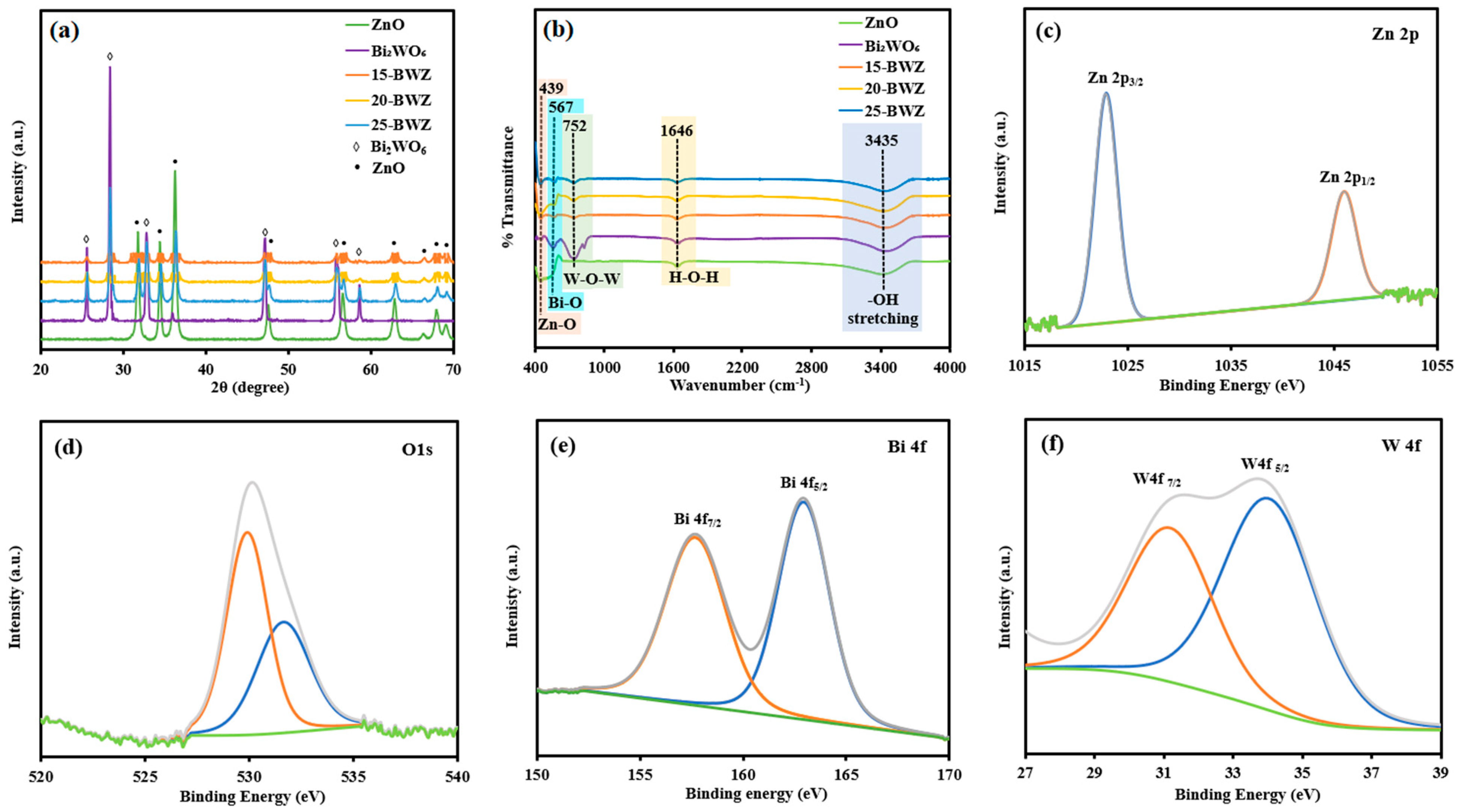
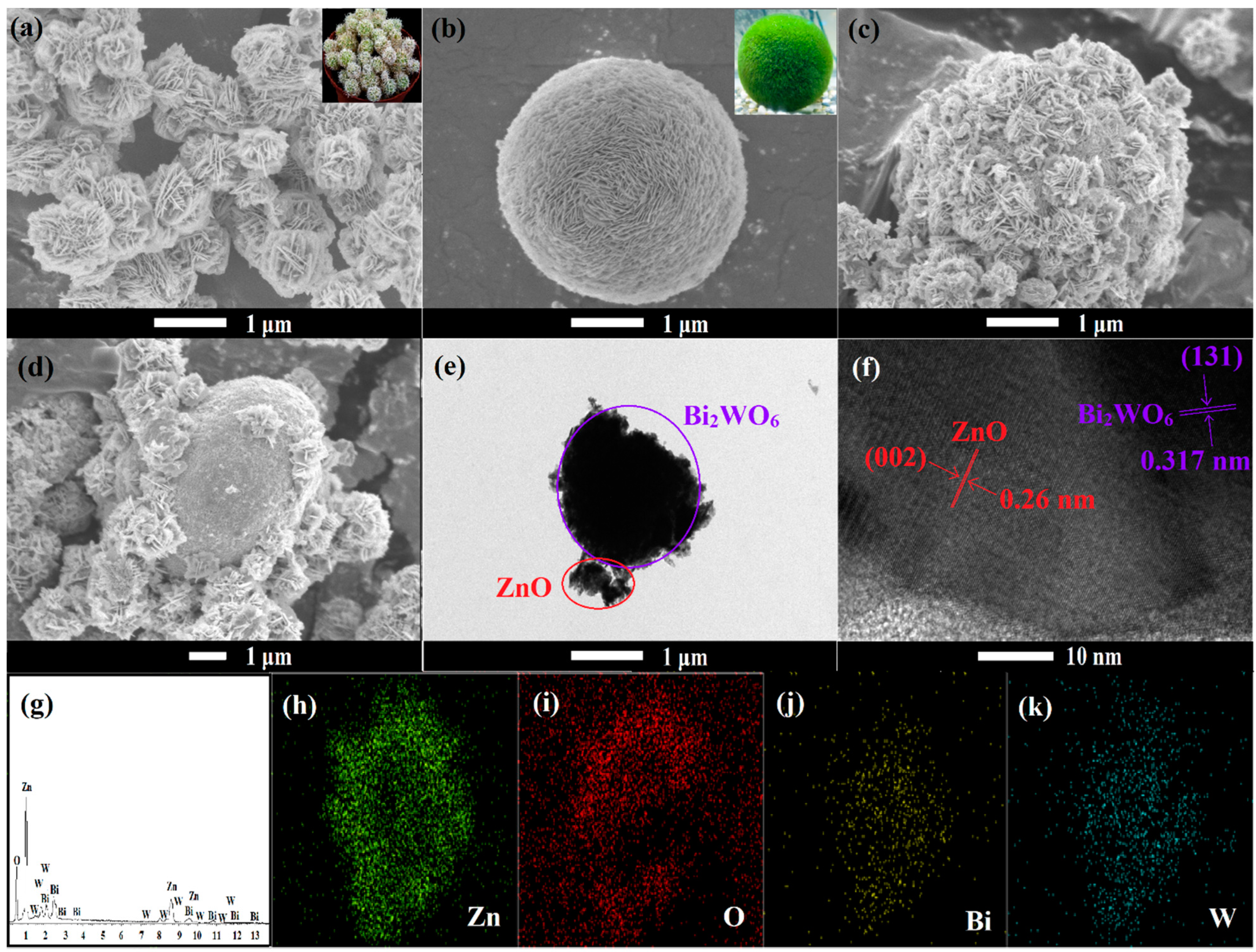

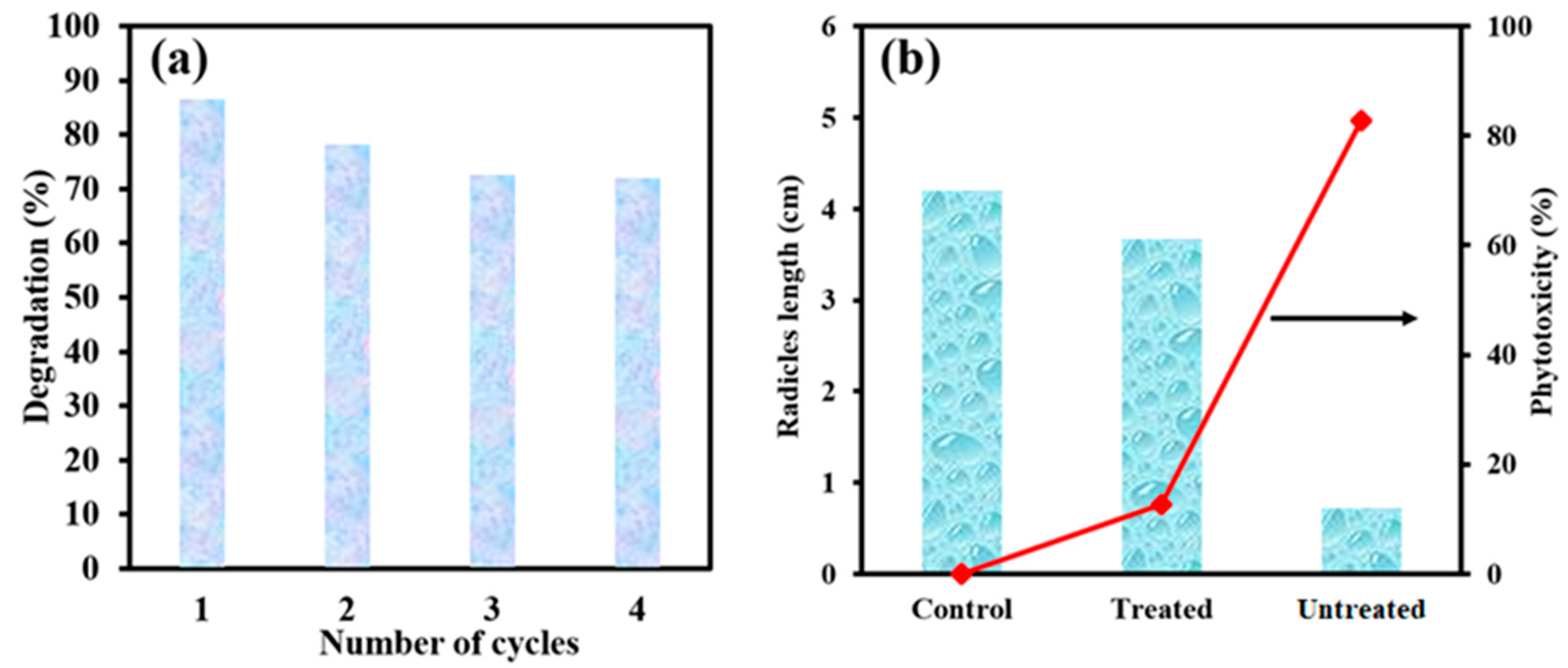
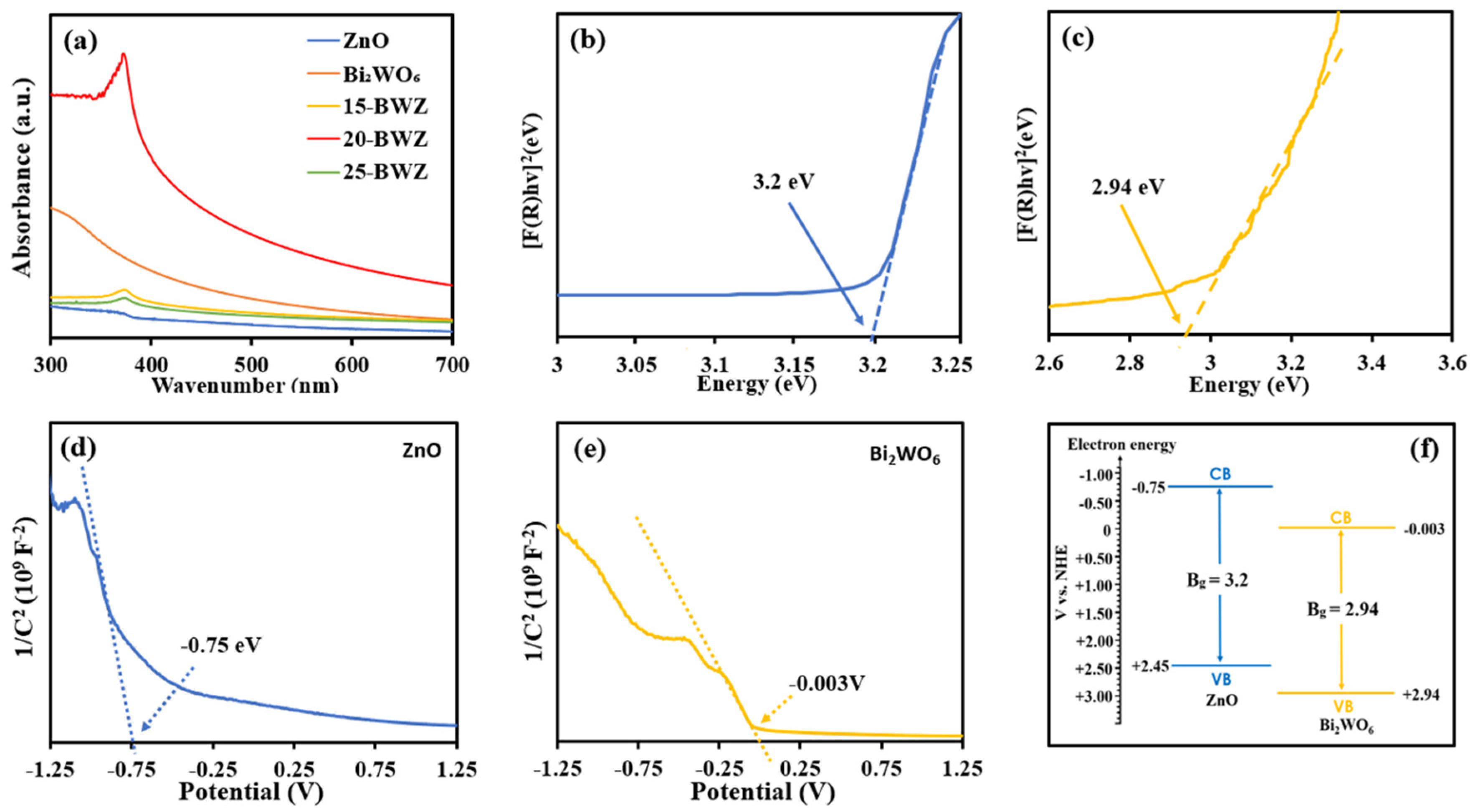
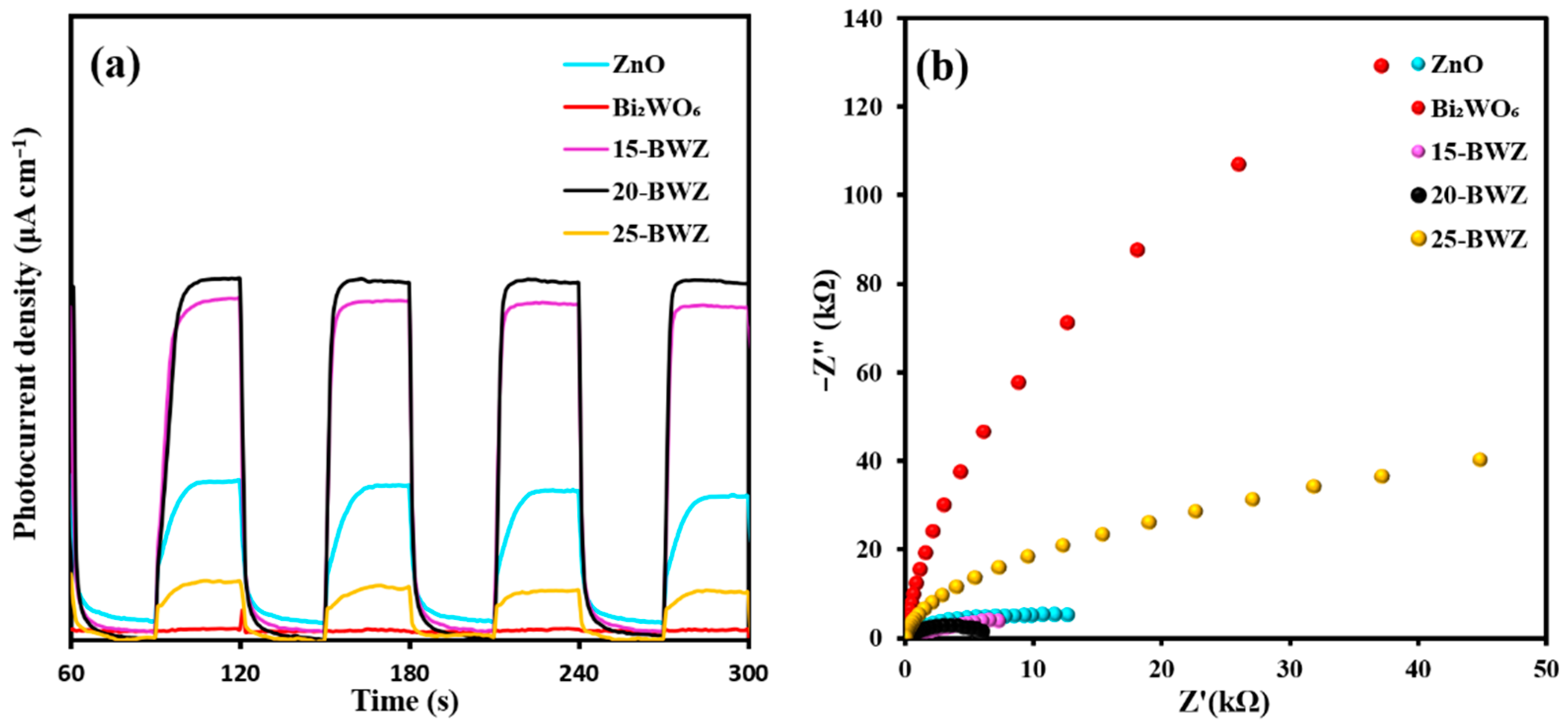

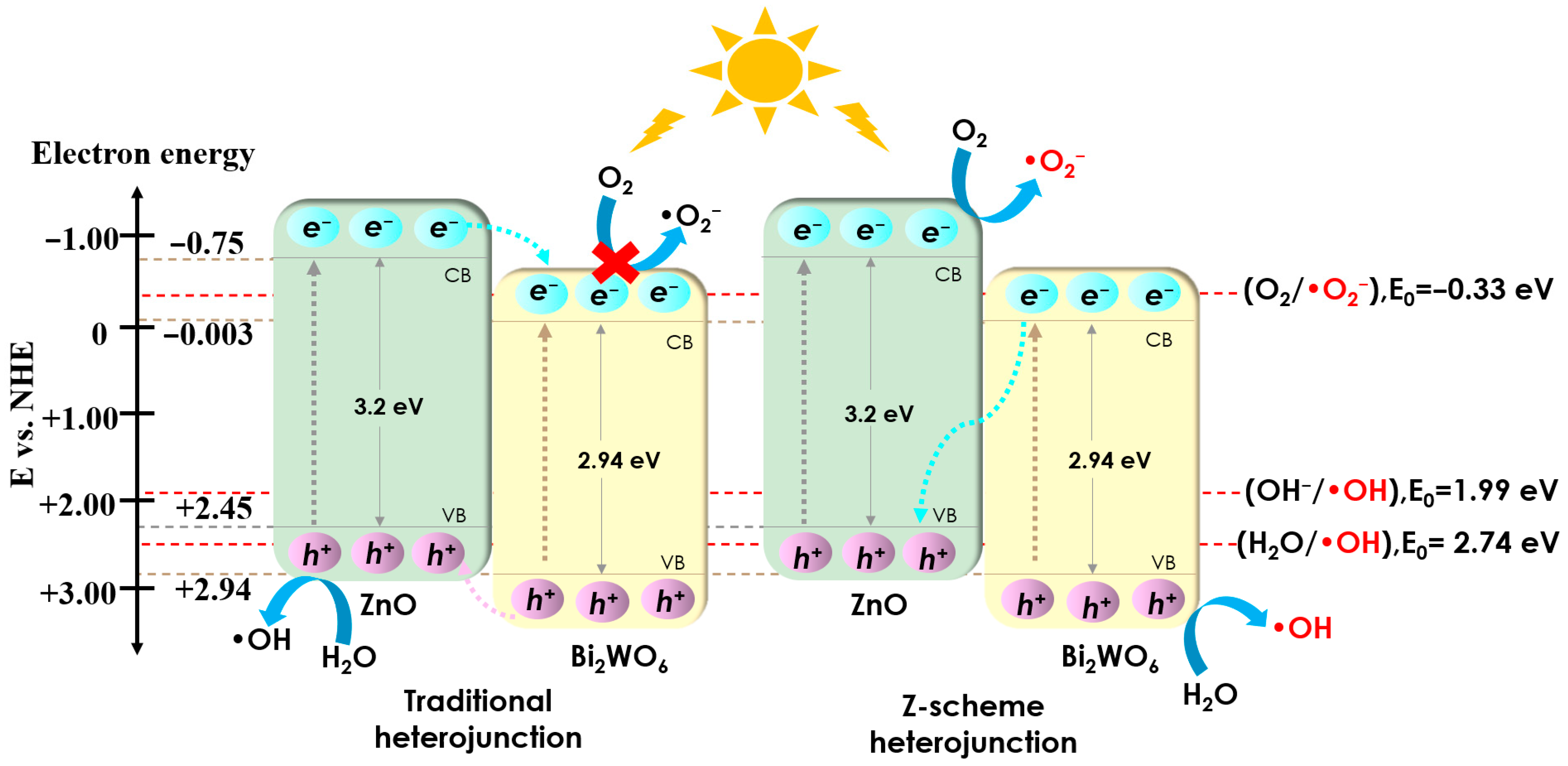
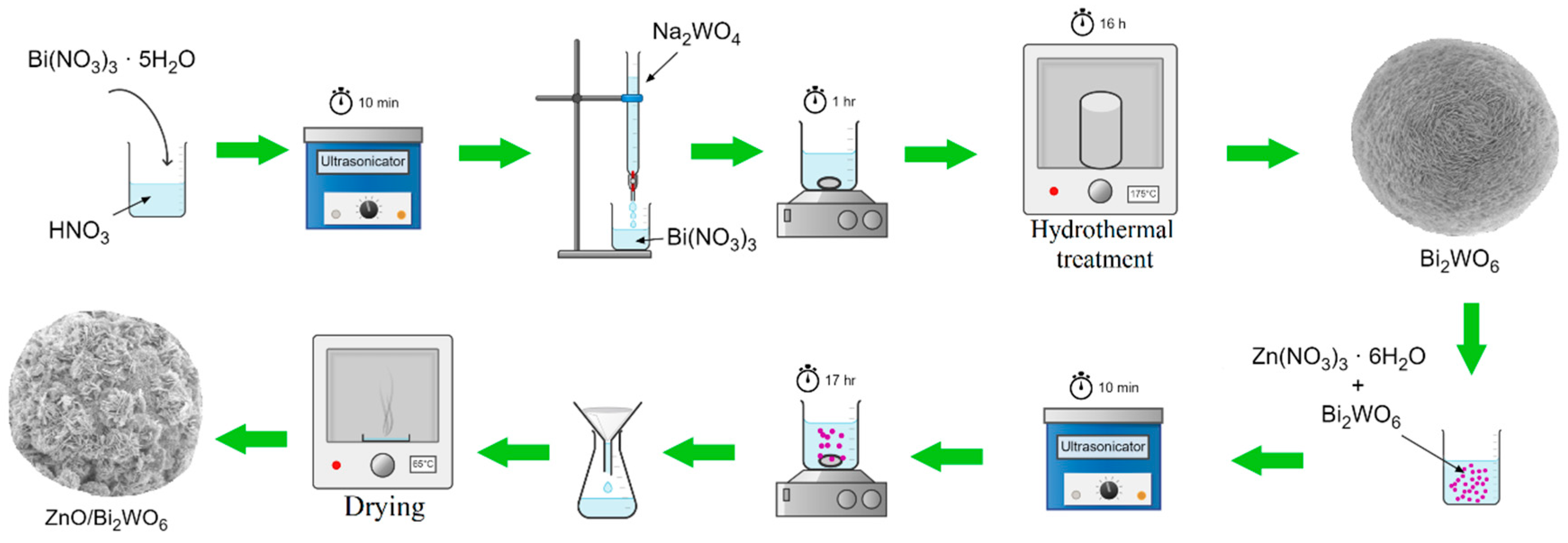
| Photocatalysts | Pollutants | Operating Conditions | Efficiency | Rate Constant, k | Ref. |
|---|---|---|---|---|---|
| TiO2 | Dimethyl phthalate (1 ppm) | Catalyst loading: 0.5 g/L 96 W UV light | 71% (180 min) | 0.0069 | [51] |
| TiO2 | Dimethyl phthalate (5 ppm) | Catalyst loading: 1 g/L 25 W UV-vis light | 60% (150 min) | 0.0061 | [52] |
| CuPc/TiO2/SiO2/Fe3O4 | Dimethyl phthalate (10 ppm) | Catalyst loading: 1.2 g/L 500 W simulated solar light | 40% (600 min) | 0.0008 | [53] |
| La/TiO2 | Dimethyl phthalate (20 ppm) | Catalyst loading: 1 g/L UV-C light | 74.4% (600 min) | 0.0023 | [54] |
|
Iron oxide/g-C3N4 /BiOBr/polythiopin | Dimethyl phthalate (20 ppm) | Catalyst loading: 2 g/L 500 W simulated solar light | 24% (360 min) | 0.0032 | [55] |
| g-C3N4 | Dimethyl phthalate (1.94 ppm) | Catalyst loading: 0.5 g/L UV-C light | 70% (120 min) | 0.0120 | [56] |
| PANI/CNT/TiO2 | Diethyl phthalate (1 ppm) | 10 W visible light | 67% (120 min) | 0.0092 | [57] |
| Ca/α-Fe2O3 | Diethyl phthalate (0.2 ppm) | Catalyst loading: 0.025 g/L 50 W UV light | 60% (300 min) | 0.0031 | [58] |
| Ce/Gd-WS2 | Dibutyl phthalate (1 ppm) | Catalyst loading: 0.2 g/L 250 W simulated solar light | 64% (60 min) | 0.0110 | [59] |
| 20-BWZ | Dimethyl phthalate (1 ppm) | Catalyst loading: 1 g/L Sunlight | 86.6% (90 min) | 0.0259 | This study |
Publisher’s Note: MDPI stays neutral with regard to jurisdictional claims in published maps and institutional affiliations. |
© 2022 by the authors. Licensee MDPI, Basel, Switzerland. This article is an open access article distributed under the terms and conditions of the Creative Commons Attribution (CC BY) license (https://creativecommons.org/licenses/by/4.0/).
Share and Cite
Chin, Y.-H.; Sin, J.-C.; Lam, S.-M.; Zeng, H.; Lin, H.; Li, H.; Huang, L.; Mohamed, A.R. 3-D/3-D Z-Scheme Heterojunction Composite Formed by Marimo-like Bi2WO6 and Mammillaria-like ZnO for Expeditious Sunlight Photodegradation of Dimethyl Phthalate. Catalysts 2022, 12, 1427. https://doi.org/10.3390/catal12111427
Chin Y-H, Sin J-C, Lam S-M, Zeng H, Lin H, Li H, Huang L, Mohamed AR. 3-D/3-D Z-Scheme Heterojunction Composite Formed by Marimo-like Bi2WO6 and Mammillaria-like ZnO for Expeditious Sunlight Photodegradation of Dimethyl Phthalate. Catalysts. 2022; 12(11):1427. https://doi.org/10.3390/catal12111427
Chicago/Turabian StyleChin, Ying-Hui, Jin-Chung Sin, Sze-Mun Lam, Honghu Zeng, Hua Lin, Haixiang Li, Liangliang Huang, and Abdul Rahman Mohamed. 2022. "3-D/3-D Z-Scheme Heterojunction Composite Formed by Marimo-like Bi2WO6 and Mammillaria-like ZnO for Expeditious Sunlight Photodegradation of Dimethyl Phthalate" Catalysts 12, no. 11: 1427. https://doi.org/10.3390/catal12111427
APA StyleChin, Y.-H., Sin, J.-C., Lam, S.-M., Zeng, H., Lin, H., Li, H., Huang, L., & Mohamed, A. R. (2022). 3-D/3-D Z-Scheme Heterojunction Composite Formed by Marimo-like Bi2WO6 and Mammillaria-like ZnO for Expeditious Sunlight Photodegradation of Dimethyl Phthalate. Catalysts, 12(11), 1427. https://doi.org/10.3390/catal12111427









